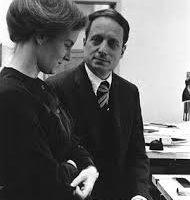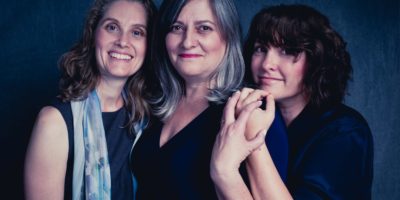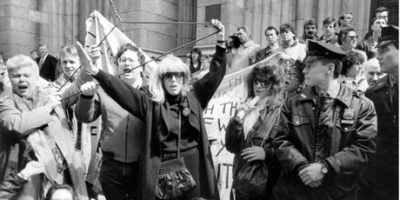Lilith Feature
Why L.A.? Why Women? And Why Now?
After leaving Mishkon, Levy wrote two books (To Begin Again and Talking to God). “I was on the road doing a lot of book tours and lecturing. Over and over, I would meet [Jewish] people who would tell me they had walked away or were raised with nothing,” she observed. “Somehow the threshold of the synagogue was intimidating, but the bookstore was a nice entry point to talk to a rabbi about what they might be going through.”
Back in Los Angeles, Levy found herself meeting Jews who were unaffiliated. “I started asking what moved them, what they struggled with. I naively had made the assumption that unaffiliated Jews were atheists, that they didn’t have a need for Jewish spiritual connection, but what I was finding more and more was that I was meeting Jews who were spiritual, who were theists, who were saying they had tried but could not find God in synagogue, that the synagogue experience had left them cold and that they were turning elsewhere for spirituality in places like Buddhism or yoga. But they weren’t abandoning their Jewish identity.”
Rabbi Levy conceptualized Nashuva nine years ago with a group of friends around her dining room table. “The goal was to create an entity that lived, taught, breathed a Jewish spirituality and connected that to acts of justice. That linked that need for prayer with action, that saw the end point of prayer not being ‘I feel better about myself’, but ‘I’m now charged to act’,” she explained.
Music was deeply important. (Nashuva has possibly the nation’s largest Jewish drum circle and an eight-member band.) “The goal was to find a musicality that was accessible and participatory, that could take you on a journey to ecstatic places and to solemn places. Melodies have a power all their own, a nonverbal, pre-verbal power, to unite and comfort, inspire, lift and calm us. As a new mother sings to an infant, no words are necessary. When the Children of Israel crossed the Red Sea, their first reaction, biblically speaking, was to sing a song.
“It’s not only about being earnest,” she added. “Lightheartedness, joy and fun are important in what we’ve created.”
Also key has been conducting services in different types of venues. “Taking Nashuva outdoors offers a whole power unto itself. So many of the Psalms are about seeing God’s hand in nature — sky, roots, roaring seas — that to be able to experience Judaism outdoors takes things to other levels.”
Then there’s the live webcast. High Holiday services, Tashlikh on the beach with drums, and Yom Kippur in particular, have upwards of 75,000 people participating live through that. “I can’t tell you how many wonderful notes we’ve gotten from people all over the world,” reported Levy, “people who are homebound, who felt they were done with Judaism, who are in hospice, entire college dorms. That’s been a really remarkable experience.”
And Levy has accomplished all of this without a traditional membership model. “If you come, you’re a member,” she says. Monthly Friday night services attract 400 people, and High Holidays can draw in over 1,000.
Levy speculates that Nashuva has also been a safe place for interfaith families.
Why does reaching the outsiders resonate so much for Levy? “Judaism is full of humor, it’s full of irony. It’s full of tension. Before abandoning it or making assumptions about it, I want people to experience it, the wealth of it, and have it kind of marinate. There are so many interesting, exciting, fascinating Jews who are at the brink of being lost to Jewish life, and I don’t want to give up on them.
“The word nashuva means ‘we will return’. It comes from the last line of Lamentations that says ‘Turn us to You, God, and we will return’. I love the reciprocity of it, the implied connection, that we all have that possibility of returning. We all have that power.”
—–
“Women have a different energy than men, whether it’s an ability to see things differently or try things without the fear of convention.”
–Ayana Morse
Changing neighborhoods are often gentrified by artists who pave the way for others, and Jewish life in Los Angeles is being invigorated by artists and creative thinkers moving back to the Holy Land of the East Side, towards Boyle Heights, the area of the city where Eastern European Jews first settled in large numbers during the first years of the twentieth century. Although Los Angeles has the second largest Jewish population in the country, most of the Jews moved from the East Side to the suburbs in the 1940s and 50s, leaving very little organized Jewish life on the East Side until now.
The modern East Side is funkier and more affordable than the staid West Side, and these young Jews are bringing a vibrancy and vitality to Jewish life in their neighborhoods and beyond. (To give you an idea of what these neighborhoods look like, do a Netflix download of The Music Box, Laurel and Hardy’s Oscar-winning 1932 short, shot in Echo Park).
In 2010, just after she began at the Silverlake Independent JCC (SIJCC), Co-Executive Director Ayana Morse co-founded East Side Jews with Jill Soloway and a group of about 10 other friends who were alumni of Reboot, a national organization that brings together, by invitation, Jews from various walks of life.
A partnership with SIJCC “emerged immediately because of my position there,” said Morse, adding, “We can offer a public gathering space, like in the 1950s when the JCCs first boomed.”




